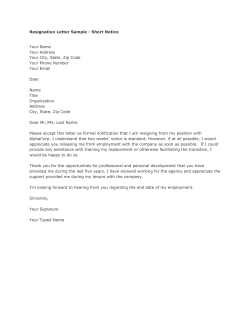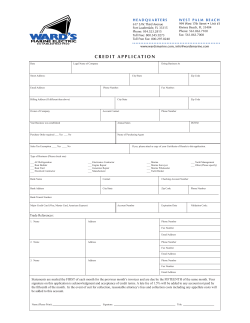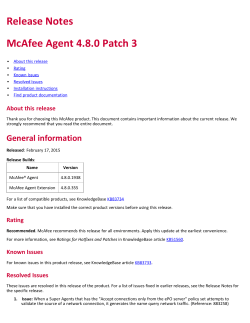
Threat Advisory: CTB
McAfee Labs Threat Advisory CTB-Locker January 21, 2015 McAfee Labs periodically publishes Threat Advisories to provide customers with a detailed analysis of prevalent malware. This Threat Advisory contains behavioral information, characteristics, and symptoms that may be used to mitigate or discover this threat, and suggestions for mitigation in addition to the coverage provided by the DATs. To receive a notification when a Threat Advisory is published by McAfee Labs, select to receive “Malware and Threat Reports” at the following URL: https://sns.snssecure.mcafee.com/content/signup_login. Summary CTB-Locker is ransomware that on execution encrypts certain file types present in the user’s system. The compromised user has to pay the attacker with a ransom to get the files decrypted. McAfee detects this threat under the following detection name[s]: BackDoor-FCKQ Downloader-FAMV Injector-FMZ Detailed information about the threat, its propagation, characteristics, and mitigation are in the following sections: Infection and Propagation Vectors Mitigation Characteristics and Symptoms Restart Mechanism McAfee Foundstone Services Infection and Propagation Vectors The malware is being propagated via spam emails; it comes with an attachment in the form of a .zip file. The .zip file is layered inside another .zip file, which contains the downloader for CTB-Locker. The spam emails may appear similar to the following: The spam messages are mostly targeting banks and financial institutions, even though infections can occur anywhere due to the methods used in propagation. The attachments in the spam emails are .zip files, some of which may be named as one of the following: malformed.zip plenitude.zip inquires.zip simoniac.zip faltboat.zip incurably.zip payloads.zip dessiatine.zip The subjects used in the spam campaign may be named as one of the following: [Fax server] +07909 546940 copy from +07540040842 Message H4H2LC68B7167E4F4 New incoming fax message, S8F8E423F9285C5 Incoming fax from +07843-982843 [Fax server]:+07725-855368 Fax ZC9257943991110 New fax message from +07862-678057 Coverage for the above mentioned detection names are available from the production DAT 7687. Mitigation Mitigating the threat at multiple levels such as file, registry, and URL could be achieved at various layers of McAfee products. Browse the product guidelines available here (click Knowledge Center, and select Product Documentation from the Content Source list) to mitigate the threats based on the behavior described below in the “Characteristics and symptoms” section. Refer the following KB articles to configure Access Protection rules in VirusScan Enterprise: KB81095 - How to create a user-defined Access Protection Rule from a VSE 8.x or ePO 5.x console KB54812 - How to use wildcards when creating exclusions in VirusScan Enterprise 8.x HIPS To blacklist applications using a Host Intrusion Prevention custom signature, refer to KB71329. To create an application blocking rules policies to prevent the binary from running, refer to KB71794. To create an application blocking rules policies that prevents a specific executable from hooking any other executable, refer to KB71794. To block attacks from a specific IP address through McAfee NitroSecurity IPS, refer to KB74650. Disclaimer: Use of *.* in an access protection rule would prevent all types of files from running and being accessed from that specific location. If specifying a process path under Processes to Include, the use of wildcards for Folder Names may lead to unexpected behavior. Users are requested to make this rule as specific as possible. Users of the following products may want to check if GTI is enabled to block the IP addresses being used to send spam: SaaS Email and Web Security 5.6 Email Gateway (7.x or later) 7.5 Email Gateway (7.x or later) 7.0 GroupShield for Microsoft Exchange 7.0.x Desktop users need to enable the Outlook plugin and also install the Site Advisor browser plugin to detect the spam attachment before it is opened and block access to the malicious domains. Characteristics and Symptoms Description CTB-Locker belongs to a family of malware that encrypts the compromised user’s files available in the system and demands the user to pay a ransom amount to retrieve the files. CTB is an acronym for Curve Tor Bitcoin. Curve refers to the fact that the malware uses Elliptical Curve Encryption, which the author claims is the equivalent of RSA-encryption with a 3072-bit key. On execution, CTB-Locker usually copies itself into the %temp% folder with a random name (7 characters) , such as: C:\DOCUME~1\ADMINI~1\LOCALS~1\Temp\fzjujkn.exe CTB-Locker injects malicious code into svchost.exe and the injected code will in turn execute the dropped file from the %temp% location. The malware then creates a scheduled task (< random 7 characters >.job) to execute the above mentioned dropped binary at system startup, for example: C:\WINDOWS\Tasks\cderkbm.job It also creates a random named mutex to ensure that only one instance of malware is running at a time. This injected code, in svchost.exe, will then encrypt the files with the following extensions: .pdf .xls .ppt .txt .py .wb2 .jpg .odb .dbf .md .js .pl, etc. After the files have been encrypted successfully by the malware, a pop-up window will appear on the screen, with the countdown time of 96 hours to get the decrypted files back and some other details as shown below: On clicking the View button, the infected user can see the list of files that have been encrypted and other details about how to make a payment and get the decrypted files back. Restart Mechanism The following scheduled task could enable the Trojan to execute every time when Windows starts: C:\WINDOWS\Tasks\<7 random characters>.job Getting Help from the McAfee Foundstone Services team This document is intended to provide a summary of current intelligence and best practices to ensure the highest level of protection from your McAfee security solution. The McAfee Foundstone Services team offers a full range of strategic and technical consulting services that can further help to ensure you identify security risk and build effective solutions to remediate security vulnerabilities. You can reach them here: https://secure.mcafee.com/apps/services/services-contact.aspx This Advisory is for the education and convenience of McAfee customers. We try to ensure the accuracy, relevance, and timeliness of the information and events described; they are subject to change without notice. Copyright 2014 McAfee, Inc. All rights reserved.
© Copyright 2025




















